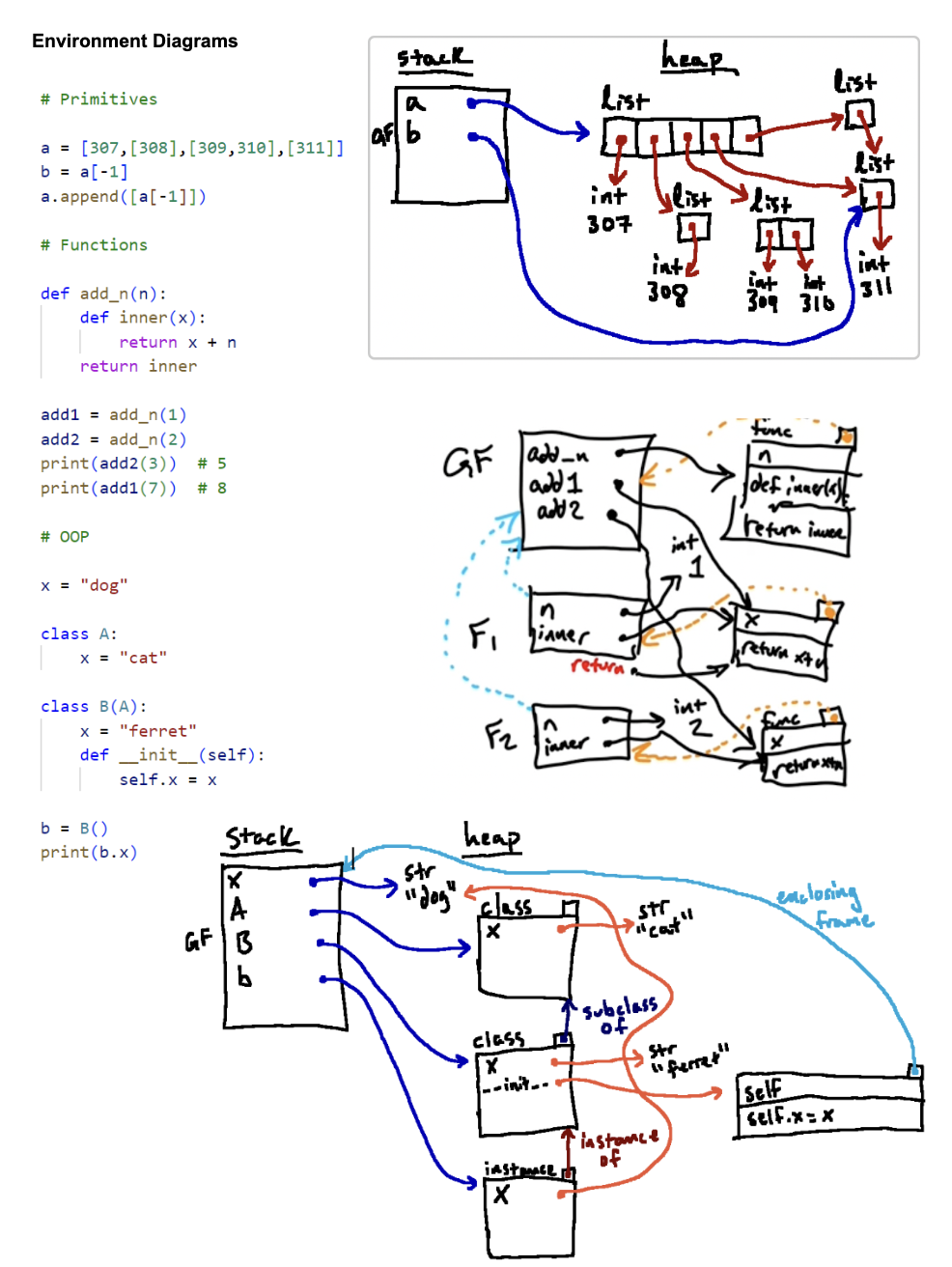6.101: Fundamentals of Programming
This is a very rough summary of what we learned in 6.101: Fundamentals of Programming, which was taught in Python. Note that most of the learning came from coding practice in labs, the below is just a summary.
Data Structures
e, i, k, default, iter, iter1, iter2, iter3 = None
seq_x, seq_y, cond_x, cond_y, func, Shape, point_in_rect = None
s, a, b = None
# Strings
S = ""
S.upper() # Also S.lower()
S.strip().split(",")
one = "ook".replace("ok", "ne")
S.index(s, a, b) # First index of s in S[a:b], or error
# Lists (also tuples, which are immutable)
L, L2 = [1, 2, 3]
L.append(e)
L.insert(i, e) # Insert e before i (0 -> Start of array)
L.extend(L2) # Also L + L2
L.pop(i) # Returns L[i], i is optional (0 by default)
L.remove(e) # Find and remove first occurence of value
L.index(e, a, b) # First index of e in L[a:b], or error
out = [] # [ func(x, y)
for x in seq_x: # for x in seq_x
if cond_x: # if cond_x
for y in seq_y: # for y in seq_y
if cond_y: # if cond_y ]
out.append(func(x, y)) # List comprehensions
# Sets
S, S2 = set(), frozenset()
S.add(e)
S.discard(e) # Or S.remove(e) which raises KeyError on fail
S.union(S2) # S | S2, e present in at least one set
S.intersection(S2) # S & S2, e present in both sets
S.difference(S2) # S - S2, e present in S but not in S2
# Dictionaries
D = {}
D.setdefault(k, default)
D.get(k, default)
D.pop(k) # del D[k]
D.items() # D.keys(), D.values(), returns generator
D = {k: v for k, v in iter if k != v}
# Iterables and generators
def my_range(start, end): # Generator
if start >= end: return
yield start
yield from my_range(start+1, end)
for e in reversed(iter): print(e)
for i, e in enumerate(iter): print(i, e)
for a, b, c in zip(iter1, iter2, iter3): print(a, b, c)
Common Patterns
# List comprehensions
def poly_evaluate(p, x):
return sum([coeff * x**i for i,coeff in enumerate(p)])
# Recursion
def sum_nested(x):
"""
>>> sum_nested([[1, 2], [3, [4, 5]], [[[[[6]]]]]])
21
"""
if not x: return 0
elif isinstance(x[0], list):
return sum_nested(x[0]) + sum_nested(x[1:])
else:
return x[0] + sum_nested(x[1:])
# Decorators
def memoize(func):
cache = {}
def _mfunc(*args):
if args not in cache: cache[args] = func(*args)
return cache[args]
return _mfunc
@memoize
def fib(n):
return n if n < 2 else fib(n-2) + fib(n-1)
# OOP
class Rectangle(Shape):
def __init__(self, lower_left, width, height):
Shape.__init__(self)
self.ll = lower_left
self.w = width
self.h = height
@property
def center(self):
return (self.ll[0]+self.w//2, self.ll[1]+self.h//2)
@center.setter
def center(self, v):
self.ll = (v[0]-self.w//2, v[1]-self.h//2)
def __contains__(self, p):
return point_in_rect(self, p)
# Misc
a, b = b, a # Swap
x = 1
def outer():
global x # Cannot modify x without this
x += 1
y = x
def inner():
nonlocal y # Cannot modify y without this
y += 1
inner()
def bfs(neighbors_function, start, goal_test):
# start is the initial state, goal_test returns boolean
if goal_test(start):
return (start, )
agenda = [(start, )]
visited = {start}
while agenda:
this_path = agenda.pop(0)
terminal_state = this_path[-1]
# neighbors_function returns iterable with neighbors
for neighbor in neighbors_function(terminal_state):
if neighbor not in visited:
new_path = this_path + (neighbor,)
if goal_test(neighbor):
return new_path
agenda.append(new_path)
visited.add(neighbor)
Python’s Internal Model
A simplified model of how Python works internally. The main idea is that every variable name points to something, and all new code does is create and/or change these names and pointers. See below for 3 examples:
Last updated: 03 September 2023